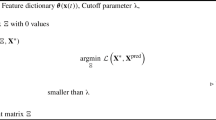Abstract
Considered are stable linear SISO plants subjected to unknown-but-bounded disturbances. For such plants, the potentials of the two methods of active identification are Compared—the instrumental variable method and the finite-frequency identification method. The relation between these methods is established in the situation where the measurable input is represented by a test signal in the form of the sum of harmonics, whose number is equal to the state space dimension of the plant. The advantages of the finite-frequency method are twofold: it reduces both the sensitivity of the estimates of the plant coefficients to the errors in experimental data and the effect of the dependence between the measurable input and exogenous disturbance on the accuracy of identification. These extra capabilities are provided by the self-tuning of the frequencies of the test signal.
Similar content being viewed by others
REFERENCES
Fomin, V.N., Fradkov, A.L., and Yakubovich, V.A., Adaptivnoe upravlenie dinamicheskimi ob"ektami (Adaptive Control of Dynamic Plants), Moscow: Nauka, 1981.
Ljung, L., System Identification. Theory for the User, Englewood Cliffs: Prentice-Hall, 1987. Translated under the title Identifikatsiya sistem. Teoriya dlya pol'zovatelya, Moscow: Nauka, 1991.
Granichin, O.N. and Polyak, B.T., Randomizirovannye algoritmy otsenivaniya i optimizatsii pri pochti proizvol'nykh pomekhakh (Randomized Algorithms of Estimation and Optimization under Almost Arbitrary Noise), Moscow: Nauka, 2003.
Bunich, A.L. and Bakhtadze, N.N., Sintez i primenenie diskretnykh sistem upravleniya s identifikatorom (Design and Applications of Discrete Time Control Systems with Identifier), Moscow: Nauka, 2003.
Aleksandrov, A.G., The Finite-Frequency Method of Identification, Proc. 10th IFAC Sympos. Syst. Identification, 1994, vol. 2, pp. 523–527.
Wong, K.Y. and Polak, E., Identification of Linear Discrete Time Systems Using Instrumental Variable Method, IEEE Trans. Automat. Control, 1967, vol. 12, pp. 707–718.
Aleksandrov, A.G., The Frequency Parameter Method, Avtom. Telemekh., 1989, no. 12, pp. 3–15.
Aleksandrov, A.G., Finite-Frequency Identification: Self-tuning of a Test Signal, in Robust Control and Frequency Identification, Elektrostal': EPI MISiS, 2004, pp. 67–97.
Aleksandrov, A.G., Frequency Adaptive Control for a Stable Plant Subjected to Unknown-but-bounded Disturbances, Avtom. Telemekh., 2000, no. 4, pp. 106–116.
Aleksandrov, A.G., Finite-Frequency Identification: Frequency Bounds for Test Signals, Avtom. Telemekh., 2001, no. 11, pp. 3–14.
Rabkin, G.L., Mitrofanov, B.A., and Shterenberg, Yu.O., On the Determination of Numerical Values of the Coefficients of Transfer Functions of Linearized Blocks and Systems from Experimental Frequency Response, Avtom. Telemekh., 1955, vol. 16, no.5, pp. 488–494.
Kardashov, A.A. and Karnyushin, L.V., Determination of the System Parameters from Experimental (Given) Frequency Response, Avtom. Telemekh., 1958, vol. 19, no.4, pp. 334–345.
Pintelon, R., Guillaume P., Rolain Y., et al., Parametric Identification of Transfer Functions in the Frequency Domain. A Survey, IEEE Trans. Automat. Control, 1994, vol. 39, no.11, pp. 2245–2260.
Aleksandrov, A.G., Frequency Regulators, Avtom. Telemekh., 1991, no. 1, pp. 22–33.
Graebe, S.F., Robust and Adaptive Control of an Unknown Plant: A Benchmark of New Format, Proc. 12th World Congress of IFAC, Sydney, 1993, vol. III, pp. 165–170.
Aleksandrov, A.G. and Orlov, Yu.F., ADAPLAB-M: The Routine for Identification with Self-tuning of a Test Signal, Proc. IV Int. Conf. “System Identification and Control Problems” (SICPRO'2005), Moscow: Inst. Probl. Upravlen., 2005, CD ISBN 5-201-14975-8.
Dyakonov, V.P. and Kruglov, V., MATLAB. Analiz, identifikatsiya i modelirovanie sistem (MATLAB. Analysis, Identification and System Modelling), St. Petersburg: Piter, 2002.
Author information
Authors and Affiliations
Additional information
__________
Translated from Avtomatika i Telemekhanika, No. 10, 2005, pp. 128–147.
Original Russian Text Copyright © 2005 by Aleksandrov, Orlov.
Rights and permissions
About this article
Cite this article
Aleksandrov, A.G., Orlov, Y.F. Comparison of the Two Methods of Identification under Unknown-but-Bounded Disturbances. Autom Remote Control 66, 1647–1665 (2005). https://doi.org/10.1007/s10513-005-0198-7
Received:
Issue Date:
DOI: https://doi.org/10.1007/s10513-005-0198-7




